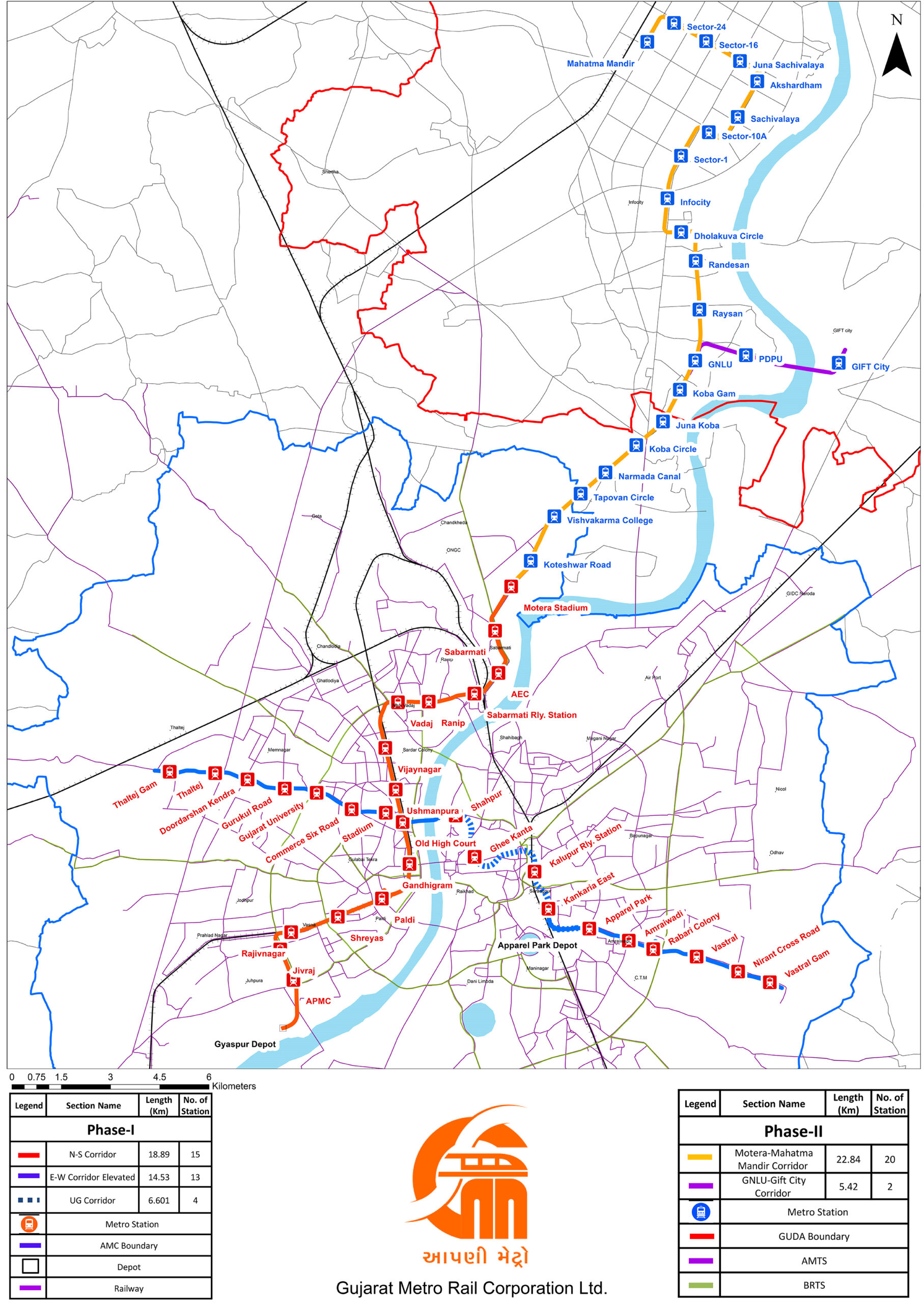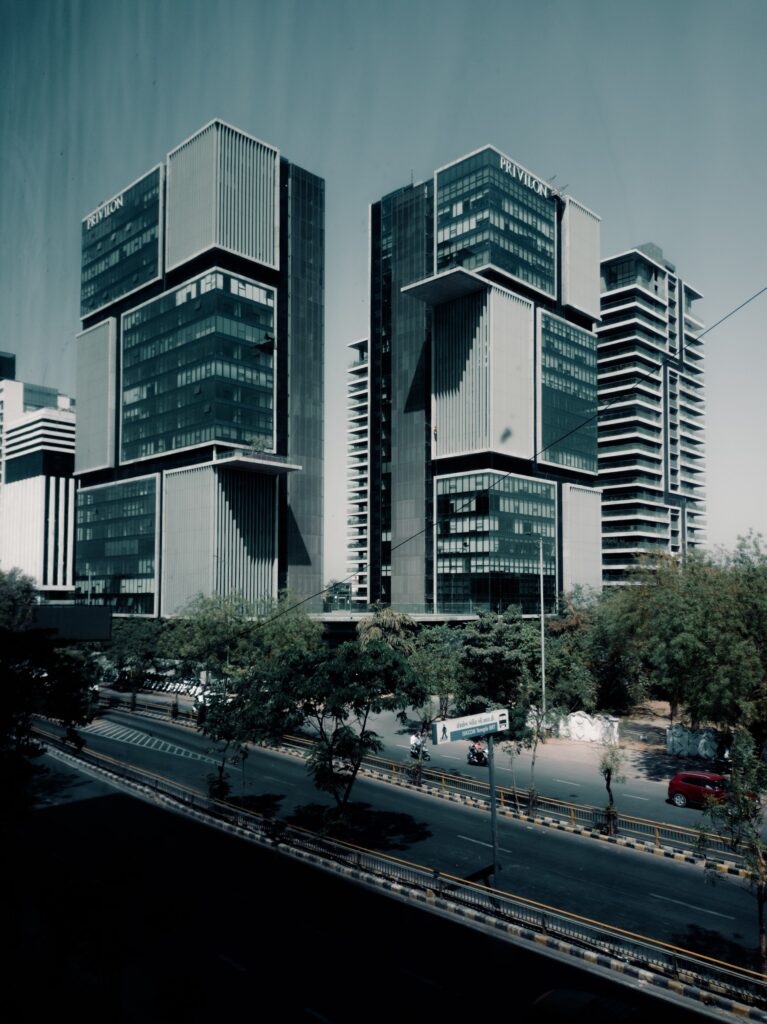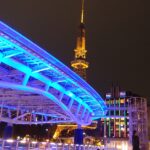Several modes of public transportation, like railroads, buses, and auto rickshaws, provide service to the city of Ahmedabad. Buses are the most widely used mode of public transportation in Ahmedabad, and their routes span the entirety of the city. Auto rickshaws are another convenient mode of transportation that can be found in abundance all around the city. In addition, the city is served by an extensive rail network, which provides a fast, easy, and inexpensive means of transportation within the metropolitan area. The Ahmedabad Janmarg BRTS is a bus rapid transit system that was recently put into operation to facilitate simpler movement around the city of Ahmedabad. Because of the dedicated lanes that this system provides for buses, it is much simpler to navigate within and around the city.
Metro system in Ahmedabad: basic information
The metro system in Ahmedabad provides a time-saving and cutting-edge means of transportation around the city. It is currently made up of two lines, which are the East-West Corridor and the North-South Corridor. Both of these lines travel all the way across the city and connect a number of its most important neighborhoods. The Ahmedabad Metro extends across a distance of more than 38 kilometers and is comprised of 39 stations. It is a reasonably priced and convenient means of traveling throughout the city.
Blue Line (East-West Corridor)
The Blue Line of the Ahmedabad Metro was the city’s first metro line and was part of the mass rapid transit rail system in Ahmedabad. It begins at Vastral Gam and ends at Thaltej Gam, covering a total distance of 21.2 kilometers, with the majority of the route being elevated. It is comprised of 18 metro stations, including two that are still under construction.
Red Line (North-South Corridor)
Phase-1 of the North-South Corridor contains 15 metro stations from APMC to Motera Stadium, 18.8 kilometers. Line is fully elevated. It will connect Motera Stadium to APMC, Vasna through Sabarmati, AEC, Sabarmati Railway station, Ranip, Vadaj, Vijaynagar, Usmanpura, Old High Court, Gandhigram, Paldi, Shreyas, Rajivnagar, and Jivraj. Except for Sabarmati Railway Station metro station, which is under construction, it opens on October 6, 2022.
The Gujarat government authorized Phase 2 in October 2017. It will extend the North-South corridor from Motera in Ahmedabad to Mahatma Mandir in Gandhinagar 23.8 km and connect Pandit Deendayal Energy University (PDEU) and GIFT City 5.4 km with a branch line from Gujarat National Law University (GN Phase-2 will include 22 stations and 28.2 kilometers of elevated route. Phase 2 tendering began in January 2020. The branch line to GIFT City should open in early 2024.
Map of Ahmedabad Metro 2023 – Free Download in PDF

The Ahmedabad Metro 2023 map is an exciting glimpse into the future of transportation in the city. With a total of 38 stations spanning two lines, the map shows the potential for efficient and reliable mass transit in the city. With the help of AI, the map could soon be used to provide real-time information on metro connections and travel times, enabling commuters to plan their journeys more effectively. With enhanced infrastructure and AI-powered solutions, Ahmedabad Metro 2023 could be a revolutionary step towards a more connected and efficient city.
Public transport tickets in Ahmedabad: Best types for travelers & actual prices
Ahmedabad is a bustling city, and getting around can be a challenge. Fortunately, the public transportation system offers a range of ticketing options to ensure you can get where you need to go. Here, we’ll take a look at the different types of tickets available and what prices you should expect to pay.
The most common type of ticket for public transportation in Ahmedabad is the prepaid card. These cards can be purchased from the Ahmedabad Municipal Transport Service (AMTS) and are valid on all AMTS buses in the city. The cards come in various denominations, from ₹50 to ₹500, and can be loaded with additional credit as required.
For visitors who are only in the city for a short period of time, a one-day ticket is available. This ticket costs ₹30 and is valid for 24 hours from the time of purchase. There is also a three-day ticket, which costs ₹60 and is valid for 72 hours from the time of purchase.
If you plan to use the public transportation system more frequently, you can purchase a monthly pass. These passes cost ₹150 and are valid for 30 days from the time of purchase. Passes can be purchased from the AMTS office or authorized agents.
For those who are looking for a more convenient way to travel, the AMTS also offers a mobile ticketing system. This system allows you to purchase tickets using your mobile phone. Tickets can be purchased from the AMTS website or through the AMTS mobile app.
Overall, the public transportation system in Ahmedabad is a convenient and affordable way to get around the city. For tourists who are only visiting for a few days, the best option would be to purchase a three-day ticket, which costs ₹60 and is valid for 72 hours from the time of purchase. This ticket gives you the flexibility to get around the city without having to worry about running out of credit or having to purchase additional tickets.
Summary of fares for public transport in Ahmedabad
- The most common type of ticket for public transportation in Ahmedabad is the prepaid card, which comes in denominations of ₹50 to ₹500 and can be loaded with additional credit as required
- For visitors who are only in the city for a short period of time, a one-day ticket (₹30) or three-day ticket (₹60) can be purchased
- Monthly passes (₹150) are available for those who plan to use the public transportation system more frequently
- The three-day ticket (₹60) is the best option for tourists who are only visiting for a few days
Timetables & Schedules of Ahmedabad Metro System
The Ahmedabad Metro system is the first metro system in India to be built outside of a metro city. The Ahmedabad Metro system operates from 6 a.m. to 10 p.m. daily, with trains running every 10 minutes between 6 am and 10 am, and then every 15 minutes from 10 a.m. to 10 p.m. In addition, the metro system runs special express services during peak hours.
What Are Other Options For Public Transportation in Ahmedabad?
In addition to the metro, Ahmedabad, which is one of the largest cities in India, provides residents with a variety of options for public transit. Auto-rickshaws, buses, and even the BRTS (Bus Rapid Transit System) are all examples of these types of transportation. In Ahmedabad, auto-rickshaws are the most popular mode of public transportation. Not only are they inexpensive and convenient, but they are also one of the most prevalent ways to get around the city. The BRTS is a dedicated bus route that travels along the major arterial highways that run through the city, and buses are available everywhere else in the city as well.
bus rapid transit system
Gujarat in India. It is a bustling metropolis that functions as a significant hub for many modes of transportation. One of the most crucial aspects of getting around the city is using the public bus transit system.
The Ahmedabad Municipal Transport Service (AMTS) is the organization responsible for running the city’s public bus system. This service offers a network of buses that travel to all parts of the city, as well as certain connecting routes to cities that are located in the surrounding area. The price that you pay to ride the public bus in Ahmedabad is determined on the total distance that you travel. You are able to purchase tickets at either the bus station itself or at any authorized ticketing agent. The AMTS also provides specialized services such as express buses, which go at a faster pace than standard buses, and air-conditioned buses, which are more pleasant. Both of these services are available to riders.
The No. 1, No. 2, No. 3, and No. 4 bus routes are the ones that see the largest ridership in Ahmedabad. These lines service the most populous parts of the city in addition to providing connections to other cities in the region. Both the No. 1 and No. 2 lines leave from the Ahmedabad Central Bus Stand; however, the No. 1 line travels to Satellite Road, and the No. 2 line leaves for Naroda Road. Between Ahmedabad Central Bus Stand and Vastrapur is where the No.3 line travels, while between Ahmedabad Central Bus Stand and Dholka is where the No.4 line travels.
public TRAINS in Ahmedabad
The Ahmedabad Railway Station is the primary transportation hub for trains in the city. It is also an important connection point for a variety of long-distance and short-distance routes. The station is kept in good condition and offers a variety of services to its customers, including ticketing, stalls selling refreshments, and storage areas for passengers’ luggage. The city of Ahmedabad is home to a number of different train stations in addition to the Ahmedabad Railway Station. Some of these stations are Sabarmati, Kalupur, and Mahatma Gandhi Road.
In Ahmedabad, one can board a variety of trains, some of which go at extremely high speeds, such as express and superfast trains. The fastest way to travel between two cities is by taking an express train, while using a superfast train, which is somewhat slower but offers more comfort and convenience, will take slightly longer. Passengers might also have access to sleeping coaches or air-conditioned coaches, depending on the itinerary.
The train links between Ahmedabad and other major cities, including as Mumbai, Delhi, Pune, and Jaipur, are among the most essential. The fastest train to Mumbai is called the Mumbai Rajdhani Express, and it takes slightly more than nine hours to travel the journey. The Delhi-Ahmedabad Express travels the distance between the two cities, which is typically fourteen hours long, in that amount of time. Both the Pune-Ahmedabad Express and the Jaipur-Ahmedabad Express are also considered to be very significant trains.
How To Get From Sardar Vallabhbhai Patel International Airport (AMD) To The City Center With Public Transport?
If you have the appropriate knowledge, getting from Sardar Vallabhbhai Patel International Airport (SVPI) to the heart of the city is going to be a snap. There are many different modes of public transportation to choose from, each of which will bring you to your destination in a timely and hassle-free manner.
Taking the Ahmedabad City Bus Service from SVPI to the city center is the quickest and easiest way to make the journey. This service operates at consistent intervals throughout the day and provides direct connections to the central business district. The SVPI campus is the first stop on the bus route, and it concludes at the city bus stand. The ticket is really reasonable, and the trip will take around a quarter of an hour.
The Ahmedabad Metro Service is an excellent choice for travelers who are interested in taking a path that leads more directly to the heart of the city. The SVPI Metro Station is the starting point of the route, and the center of the city is where it concludes. The trip will take roughly twenty minutes, and the metro runs at regular intervals throughout the travel. Additionally, the meal is fairly reasonable in price.
The Gujarat State Road Transport Corporation (GSRTC) offers a shuttle service to the city center for those who are searching for an alternative that is a bit more opulent. Although it is more expensive than taking the bus or the subway, using this service will get you to the heart of the city in around 15 minutes.
how to spend 3 days in Ahmedabad?
Visit the Sabarmati Ashram, a location of spiritual significance and the former residence of Mahatma Gandhi, on the very first day of your trip. It is an excellent location for gaining a profound understanding of the history and culture of the city. After you have finished your tour of the ashram, you can take a stroll through the historic architecture of the old city and pay a visit to the Jama Masjid, Gandhi Road, and the well-known Bhadra Fort.
You will get the opportunity to travel to the famous Kankaria Lake on the second day of your excursion. You can take a leisurely stroll in the garden, go on an adventure through the zoo, and enjoy a ride on the boat here. You may also go to the Calico Museum of Textiles if you want to learn more about the weaving business in the city and see the magnificent art and craft that comes from it. You should go to Manek Chowk in the evening so that you may indulge in some mouthwatering street cuisine and revel in the vibrant environment there.
The world-famous Akshardham temple, which is an architectural marvel and devoted to Lord Swaminarayan, is waiting for you on the third day of your stay in this city. After you have finished viewing the temple, you can take a stroll around the Law Garden Market to look at the various stalls selling mementos and peruse the other shops. After that, you can visit some of the city’s most famous nightlife venues, where you can listen to some amazing music and let loose all night long.
What other metro systems are nearby to Ahmedabad?
The city of Ahmedabad is a significant one in India. It is famous for its colorful culture as well as its extensive past. The Ahmedabad Metro is widely regarded as one of the city’s most distinguishing characteristics. It is among the nation’s most effective and well-connected metro services, making it one of the best in the business. Nevertheless, it isn’t the only metro system in the surrounding area. The Mumbai Metro, the Bangalore Metro, the Kolkata Metro, and the Hyderabad Metro are some of the other metro systems that are located in close proximity to Ahmedabad. All of these systems are very well connected to one another and offer fantastic transportation options to the people living in this region.
CHECK OUT AHMEDABAD AMAZING PUBLIC TRANSPORTATION VIDEO GUIDE
Summary of our tour guide for Ahmedabad
In Ahmedabad, I have a significant amount of expertise in using the public transit system. I have experienced all aspects of the public transportation system, from auto rickshaws to the metro, and I can attest to its effectiveness, affordability, and convenience. Because of this, getting around the city and checking out the various attractions that it has to offer has been much simpler for me. While the metro system provides travelers with a dependable and comfortable mode of transportation, auto rickshaws are a terrific way to move around town quickly and cheaply. In general, the public transit in Ahmedabad is an excellent choice for traveling throughout the city, and I strongly encourage you to make use of it.
Top 5 FAQs and answers about Ahmedabad public transport?
1. How do I get around Ahmedabad?
The most common way to get around Ahmedabad is by taking the bus, which covers the entire city and its surroundings. There are also auto-rickshaws, which are a great way to get around the city quickly and cheaply. Additionally, taxis are available, which are more expensive but can be a convenient option for those in a hurry.
2. What is the best way to pay for public transport?
The Ahmedabad Municipal Corporation (AMC) has launched a smart card system called “Ahmedabad One” which allows commuters to pay for their journey using a prepaid card. This card can be recharged online or at designated outlets, and it can be used on buses, auto-rickshaws, and taxis.
3. Are there any discounts available for public transport?
Yes, the Ahmedabad Municipal Corporation offers a range of discounts to commuters, including discounts for students and senior citizens. Additionally, there are discounts for those who frequently use the public transport system.
4. Is there a night bus service in Ahmedabad?
Yes, there is a night bus service that runs from 10 pm to 5 am on weekdays and from 11 pm to 5 am on weekends. This service runs on the same routes as the regular buses, and it is a convenient way for people to get around late at night.
5. Are there any other modes of transport available?
In addition to buses, auto-rickshaws, and taxis, there are also cycle-rickshaws and cycle-taxis. Cycle-rickshaws can be found throughout the city and are a great way of getting around on a budget. Cycle-taxis are a new and increasingly popular mode of transport in Ahmedabad, and they offer a convenient and affordable way to get around.
Useful links







